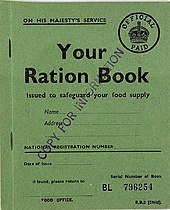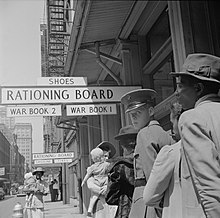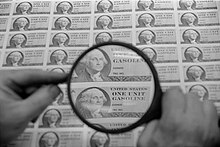Rationing is a deliberate attempt, frequently undertaken by governments, to allocate scarce supplies in the face of high demand. Severe rationing during the 1940s, 1950s and 1970s prompted American and European economists to study this subject and its consequences for product substitution.
Rationing does not exist in a free market because the excess demand would be countered by a rise in prices.
Source:
J Tobin, ‘A Survey of the Theory of Rationing’, Econometrica, vol. xx (1952) 512-53
Civilian rationing
Rationing has been instituted during wartime for civilians. For example, each person may be given what’s known as a “ration coupon” allowing him or her to purchase a certain amount of a product each month. Rationing often includes food and other necessities for which there is a shortage, including materials needed for the war effort such as rubber tires, leather shoes, clothing and fuel.
Rationing of food and water may also become necessary during an emergency, such as a natural disaster or terror attack. In the U.S., the Federal Emergency Management Agency (FEMA) has established guidelines for civilians on rationing food and water supplies when replacements are not available. According to FEMA standards, every person should have a minimum of 1 US quart (0.95 L) per day of water, and more for children, nursing mothers and the ill.[6]
Origins

First World War German government propaganda poster describing rationing with personifications of meat, bread, sugar, butter, milk and flour (1916)
Military sieges have often resulted in shortages of food and other essential consumables. In such circumstances, the rations allocated to an individual are often determined based on age, sex, race or social standing. During the Siege of Lucknow (part of the Indian Rebellion of 1857) a woman received three quarters the food ration a man received and children received only half.[7]:71 During the Siege of Ladysmith in the early stages of the Boer War in 1900 white adults received the same food rations as soldiers while children received half that. Food rations for Indian people and black people were significantly smaller.[8]:266–272
The first modern rationing systems were brought in during the First World War. In Germany, suffering from the effects of the British blockade, a rationing system was introduced in 1914 and was steadily expanded over the following years as the situation worsened.[9] Although Britain did not suffer from food shortages, as the sea lanes were kept open for food imports, panic buying towards the end of the war prompted the rationing of first sugar and then meat.[10] It is said to have in the most part benefited the health of the country,[11] through the ‘levelling of consumption of essential foodstuffs’.[12] To assist with rationing, ration books were introduced on 15 July 1918 for butter, margarine, lard, meat and sugar. During the war, average calories intake decreased only three percent, but protein intake six percent.[11] Food rationing appeared in Poland after the First World War, and ration stamps were in use until the end of the Polish–Soviet War.
Second World War[edit]

Child’s ration book, used in Britain during the Second World War
Rationing became common during the Second World War. Ration stamps were often used. These were redeemable stamps or coupons, and every family was issued a set number of each kind of stamp based on the size of the family, ages of children and income. The British Ministry of Food refined the rationing process in the early 1940s to ensure the population did not starve when food imports were severely restricted and local production limited due to the large number of men fighting the war.[13]
Rationing on a scientific basis was pioneered by Elsie Widdowson and Robert McCance at the Department of Experimental Medicine, University of Cambridge. They worked on the chemical composition of the human body, and on the nutritional value of different flours used to make bread. Widdowson also studied the impact of infant diet on human growth. They studied the differing effects from deficiencies of salt and of water and produced the first tables to compare the different nutritional content of foods before and after cooking. They co-authored The Chemical Composition of Foods, first published in 1940 by the Medical Research Council. Their book “McCance and Widdowson” became known as the dietician’s bible and formed the basis for modern nutritional thinking.[14]

Poster for the “Dig for Victory” campaign, encouraging Britons to supplement their rations by cultivating gardens and allotments
In 1939, they tested whether the United Kingdom could survive with only domestic food production if U-boats ended all imports. Using 1938 food-production data, they fed themselves and other volunteers a limited diet, while simulating the strenuous wartime physical work Britons would likely have to perform. The scientists found that the subjects’ health and performance remained very good after three months. They also headed the first ever mandated addition of vitamins and mineral to food, beginning with adding calcium to bread. Their work became the basis of the wartime austerity diet promoted by the Minister of Food Lord Woolton.[14]
Britons’ actual wartime diet was never as severe as in the Cambridge study because imports from America successfully avoided the U-boats,[15] but rationing improved the health of British people; infant mortality declined and life expectancy rose, discounting deaths caused by hostilities. This was because it ensured that everyone had access to a varied diet with enough vitamins.[16][17]
The first commodity to be controlled was gasoline. On 8 January 1940, bacon, butter and sugar were rationed. This was followed by successive ration schemes for meat, tea, jam, biscuits, breakfast cereals, cheese, eggs, lard, milk and canned and dried fruit. Fresh vegetables and fruit were not rationed but supplies were limited. Many people grew their own vegetables, greatly encouraged by the highly successful ‘digging for victory’ motivational campaign.[18] Most controversial was bread; it was not rationed until after the war ended, but the “national loaf” of wholemeal bread replaced the ordinary white variety, to the distaste of most housewives who found it mushy, grey and easy to blame for digestion problems.[19] Fish was not rationed but price increased considerably as the war progressed.[20]

Lining up at the Rationing Board office, New Orleans, 1943
In summer 1941 the British appealed to Americans to conserve food to provide more to go to Britons fighting in the Second World War. The Office of Price Administration warned Americans of potential gasoline, steel, aluminum and electricity shortages.[21] It believed that with factories converting to military production and consuming many critical supplies, rationing would become necessary if the country entered the war. It established a rationing system after the attack on Pearl Harbor.[22]:133 In June 1942 the Combined Food Board was set up to coordinate the worldwide supply of food to the Allies, with special attention to flows from the U.S. and Canada to Britain.

“An eager school boy gets his first experience in using War Ration Book Two. With many parents engaged in war work, children are being taught the facts of point rationing for helping out in family marketing.”, 02/1943
American civilians first received ration books—War Ration Book Number One, or the “Sugar Book”—on 4 May 1942,[23] through more than 100,000 school teachers, PTA groups and other volunteers.[22]:137 Sugar was the first consumer commodity rationed. Bakeries, ice cream makers and other commercial users received rations of about 70% of normal usage.[23] Coffee was rationed nationally on 27 November 1942 to 1 pound (0.45 kg) every five weeks.[24] By the end of 1942, ration coupons were used for nine other items.[22]:138 Typewriters, gasoline, bicycles, footwear, silk, nylon, fuel oil, stoves, meat, lard, shortening and oils, cheese, butter, margarine, processed foods (canned, bottled, and frozen), dried fruits, canned milk, firewood and coal, jams, jellies and fruit butter were rationed by November 1943.[25]
The work of issuing ration books and exchanging used stamps for certificates was handled by some 5,500 local ration boards of mostly volunteer workers selected by local officials. As a result of the gasoline rationing, all forms of automobile racing, including the Indianapolis 500, were banned.[26] All rationing in the United States ended in 1946.[27]

The diary of Tanya Savicheva, a girl of 11, her notes about starvation and deaths of her sister, then grandmother, then brother, then uncle, then another uncle, then mother. The last three notes say “Savichevs died”, “Everyone died” and “Only Tanya is left.” She died of progressive dystrophy shortly after the siege.
In the Soviet Union food was rationed from 1941 to 1947. In particular, daily bread rations in sieged Leningrad were initially set at 800 grams. By the end of 1941 the bread rations were reduced to 250 grams for workers and 125 for everyone else, which resulted in a surge of deaths caused by starvation. Starting from 1942 daily bread rations were increased to 350 grams for workers and 200 grams for everyone else. One of the documents of the period is the diary of Tanya Savicheva, who recorded the deaths of each member of her family during the siege.
Rationing was also introduced to a number of British dominions, and colonies, with rationing of clothing imposed in Australia, from 12 June 1942, and certain foodstuffs from 1943. Canada rationed tea, coffee, sugar, butter and mechanical spares, between 1942 and 1947. Cochin, Travancore and Madras states, of British India, elected to ration grain between the fall of 1943, and Spring 1944. While Egypt introduced a ration card based subsidy, of essential foodstuffs, in 1945, that’s persisted into the 21st century.
Peacetime rationing

Polish milk ration stamp from 1981 to 1983.
Civilian peacetime rationing of food has also occurred in history, especially after natural disasters, during contingencies, or after failed governmental economic policies regarding production or distribution, as well as due to extensive austerity programs implemented to cut or restrict public spending in countries where the rationed goods previously relied on government procurement or subsidies, as was the case in Israel and Romania.
In the United Kingdom, the rationing system remained in place for many years after the end of the War. In some respects it was more strict after the war than during it—two major foodstuffs that were never rationed during the war, bread and potatoes, went on ration after it (bread from 1946 to 1948, and potatoes for a time from 1947). Tea was still on ration until 1952. In 1953 rationing of sugar and eggs ended, and in 1954, all rationing finally ended when cheese and meats came off ration.[13] Sugar was again rationed in 1974 after Caribbean producers began selling to the more lucrative United States market.[28]
Some centralized planned economies introduced a peacetime rationing system due to food shortages in the postwar period. North Korea and China did so in the 1970s and 1980s, as did Romania during Ceausescu’s rule in the 1980s, the Soviet Union in 1990–1991, and from 1962–present in Cuba.[29]

Tel Aviv residents standing in line to buy food rations, 1954
From 1949 to 1959, Israel was under a regime of austerity, during which a state of rationing was enforced. At first, only staple foods such as oil, sugar, and margarine were rationed, but it was later expanded, and eventually included furniture and footwear. Every month, each citizen would get food coupons worth 6 Israeli pounds, and every family would be allotted a given amount of food. The average Israeli diet was 2,800 calories a day, with additional calories for children, the elderly, and pregnant women.
Following the 1952 reparations agreement with West Germany, and the subsequent influx of foreign capital, Israel’s struggling economy was bolstered, and in 1953, most restrictions were cancelled. In 1958, the list of rationed goods was narrowed to just eleven, and in 1959, it was narrowed to only jam, sugar, and coffee.

A man at a service station reads about the U.S. gasoline rationing system in an afternoon newspaper; a sign in the background states that no gasoline is available. 1974
Petroleum products were rationed in many countries following the 1973 oil crisis. The United States introduced odd–even rationing for fuels during the crisis, which allowed only vehicles with even-numbered numberplates to fill up on gas one day and odd-numbered ones on another.[30]
Poland enacted rationing in 1981 to cope with economic crisis. The rationing system initially encompassed most of the population’s daily necessities, but was gradually phased out over time, with the last ration being abolished in 1989.[31]
Cuba enacted rationing for basic goods in 1991 following the collapse of the Soviet Union, which had previously subsidised the island nation’s economy. Rationing started being phased out in the year 2000 at the end of the “special period”, as Cuba had shifted to a more diversified and self-sustaining economy. Rationing, however, was not fully abolished and instead turned into an alternative way to purchase goods, in addition to the markets. This makes a curious departure from classical rationing, as during the 2001-2019 period, the rationing system was used in addition to, instead of as a replacement for regular markets. Cubans would be able to buy a certain amount of items at ‘liberated’ prices using ration coupons at a significantly reduced rate, while still being able to purchase more at regular market prices. This ‘liberated’ system persisted even during Cuba’s period of economic growth and relative prosperity during the early and mid 2010s and enjoyed considerable popularity among the island’s citizens. Cuba later re-introduced a classical limiting rationing system in 2019, following the imposition of strict sanctions on the island by US President Donald Trump, as well as the collapse of oil shipments from Venezuela, which was facing its own economic troubles at that time. Cuba’s president pitched the new system as significantly more lenient than the 1991-2000 “special period”, though admitted that it would negatively affect consumption.[32][33][34][35]

United States gasoline ration stamps printed, but not used, as a result of the 1973 oil crisis.
Short-term rationing for gas and other fuels was introduced in the U.S. states of New Jersey and New York following Hurricane Sandy in 2012.[36]
In April 2019, Venezuela announced a 30-day electricity rationing regime in the face of power shortages.[37][38]
From 2015 to 2019, the US state of California gradually introduced permanent rationing on the use of water by limiting the daily household water expenditure.[39][40][41]
Refugee aid rations
Aid agencies, such as the World Food Programme, provide fortnightly food rations and other essentials to refugees or internally displaced persons who are registered with the UNHCR and are either living in refugee camps or are supported in urban centres. Every registered refugee is given a ration card upon registration which is used for collecting the rations from food distribution centres. The amount of 2,100 kcal allocated per person per day is based on minimal standards and frequently not achieved, such as in Kenya.[42][43]
According to article 20 of the Convention Relating to the Status of Refugees refugees shall be treated at least like nationals in relation to rationing, if there is a general rationing system in place, used for the population at large

We are a bunch of volunteers and starting a brand new scheme in our community. Your web site offered us with valuable info to paintings on. You’ve performed a formidable activity and our whole community will likely be grateful to you.